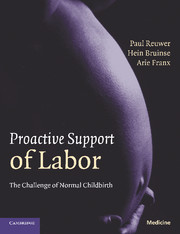Book contents
- Frontmatter
- Contents
- Foreword
- Acknowledgments
- Web-Forum
- 1 General introduction
- Section 1 A wake-up call
- Section 2 Back to basics
- Section 3 Proactive support of labor
- 12 Introductory synopsis
- 13 Nulliparous versus parous labor
- 14 Diagnosis of labor
- 15 Prevention of long labor
- 16 Personal continuity and continuous support
- 17 Amniotomy and oxytocin
- 18 Labor pain in broader perspective
- 19 Prelabor preparation
- 20 Medical pain relief revisited
- 21 Dynamic dystocia unraveled
- 22 Mechanical birth obstruction
- 23 Curtailed use of induction
- 24 Intrapartum care of the fetus
- 25 Prevention of litigation
- 26 Organizational reforms
- 27 Continual audit and feedback
- 28 Quality assessment
- 29 Hospital statistics
- 30 Sum of the parts
- Index
- References
12 - Introductory synopsis
Published online by Cambridge University Press: 08 September 2009
- Frontmatter
- Contents
- Foreword
- Acknowledgments
- Web-Forum
- 1 General introduction
- Section 1 A wake-up call
- Section 2 Back to basics
- Section 3 Proactive support of labor
- 12 Introductory synopsis
- 13 Nulliparous versus parous labor
- 14 Diagnosis of labor
- 15 Prevention of long labor
- 16 Personal continuity and continuous support
- 17 Amniotomy and oxytocin
- 18 Labor pain in broader perspective
- 19 Prelabor preparation
- 20 Medical pain relief revisited
- 21 Dynamic dystocia unraveled
- 22 Mechanical birth obstruction
- 23 Curtailed use of induction
- 24 Intrapartum care of the fetus
- 25 Prevention of litigation
- 26 Organizational reforms
- 27 Continual audit and feedback
- 28 Quality assessment
- 29 Hospital statistics
- 30 Sum of the parts
- Index
- References
Summary
Posing the right questions with an open mind often provides answers that are self-evident. A critical analysis of mainstream childbirth practice identified (iatrogenic) long labors and delayed treatment of dysfunctional labor as the main contributors to women's dissatisfaction with their childbirth experience and as the root cause of high operative delivery rates (Section 1). Clearly, prevention of long labor is important. A reappraisal of the fundamental biophysics of parturition highlighted the physiological preconditions required for a smooth, spontaneous, and safe delivery (Section 2). The most significant themes with the most important practical consequences were:
The need for care of the laboring mother to be based on a clear understanding of what is going on during labor and to have clear definitions.
The rejection of the notion of latent labor.
The identification of unnecessary induction as a cause of failed labor and cesarean delivery.
The foregoing analyses touch the very heart of current childbirth practices and implicitly provide the clue to structural improvements: a systematic approach to normal childbirth – proactive support of labor – which will be explained in full detail in this section. Before we begin, though, full credit must first be given to the original inventors of this method of care with a brief tour back to its Irish cradle and a comment on some stubborn and widespread misunderstandings.
- Type
- Chapter
- Information
- Proactive Support of LaborThe Challenge of Normal Childbirth, pp. 95 - 103Publisher: Cambridge University PressPrint publication year: 2009



